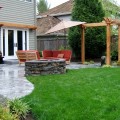Garden Landscaping Design
The ultimate intention of garden landscaping design is to create an aesthetic unity between architecture, lawn, and tree growth that ultimately results in a feeling of peace and inner harmony when perceived. Gardens have an almost magical way of tying together elements that are very diverse in their own right. Forms such as patios, driveways, walkways, arbors, outdoor buildings, swimming pools, outdoor water features, and trees all can be tied to the geometry of the home through the intermediary power of professional garden design.
In terms of feeling, the most important thing that garden landscaping should do is to extend a sense of warmth and invitation to the viewer. Vegetation is alive, and as such carries with it the vibrant fire of life itself within its leaves and stems. By sculpting vegetation into forms and geometric patterns, professional garden specialists create a realm of outdoor living that looks far more attractive than even the finest rooms inside the home. Objects that placed within the vegetation add additional vertical impact and establish focal points.
Focal points are essential to professional garden landscaping design because they provide the eye something to rest on. This allows a person to pause and then begin to slowly explore the rest of the garden. When guests arrive, this creates a very sublime and beautiful moment when they see the garden for the first time. Its shape, size, and color are magnified through one or more focal points that both establish mood and direct attention onward to other points of interest.
One of the most important ways of directing attention is through navigational passageways such as walkways and entrances. An entry can be something as simple as a wrought iron fence, or it can be much more elaborate, such as a masonry wall with an arched entrance. In some instances, pergolas and arbors are also used to create drama and a heightened sense of grand entrance to a large or very formal garden.
Garden landscaping design works best when it is planned with carefully selected plant materials that are arranged with appropriate designs. Too many different kinds of plants and colors of flowers will bombard the mind a patchwork explosion of sense instead of a controlled, deliberate, unified field of aesthetic. This mistake is commonly made by DIY gardeners and cheap yard services companies who think that more is better, and the more is merrier.
Instead, however, the real secret to professional garden landscaping design is the repetition of key elements. This can be achieved with just a few plant species interspersed with the right hardscape forms that work together to unify the architecture of the home with other features on the landscape
Such repetition is found in Nature itself. Any valley, beach, forest, mountain, or desert will immediately bear this out. There is always some kind of recognizable, repeating pattern in the grasses, shrubs, flowers, and trees one finds in these environments. This simple beauty of Nature is duplicated impeccably by garden landscape design specialists whose work emphasizes an ease of geometry, pattern, and style with a less-is-more approach that is subtle and suggestive; never strong or overpowering.

